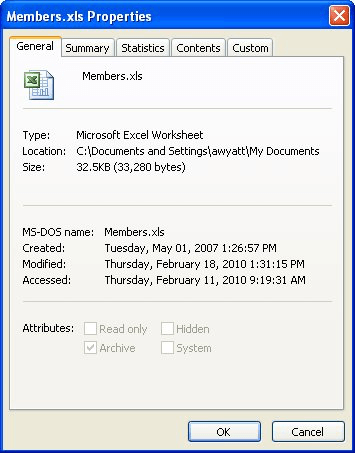Please Note: This article is written for users of the following Microsoft Excel versions: 97, 2000, 2002, and 2003. If you are using a later version (Excel 2007 or later), this tip may not work for you. For a version of this tip written specifically for later versions of Excel, click here: Finding the Size of a Workbook.
Written by Allen Wyatt (last updated October 23, 2021)
This tip applies to Excel 97, 2000, 2002, and 2003
Mike wonders if there is a worksheet function that will show him the size, in bytes, of a workbook without using a macro.
The size of a workbook in Excel can become very large, depending on the information it contains. Keeping track of the size is important and can be accomplished a couple of different ways.
If you don't want to use a macro, Excel keeps track of various pieces of information about a file in the Properties dialog box.

Figure 1. The General tab of the Properties dialog box.
In the General tab, Excel displays the size of the file. You will also see other information about the file in this tab including the type of file and who created it. Obtaining the file size is simple using this process, but it does not allow you to see the workbook size on the worksheet itself. Unfortunately, there is no way around it; you will need to use a macro. The following is a good example of one you could use:
Function wbksize()
myWbk = Application.ThisWorkbook.FullName
wbksize = FileLen(myWbk)
End Function
To use this macro within a worksheet, just type the following in any cell:
=wbksize()
The file size is displayed in bytes.
Note:
ExcelTips is your source for cost-effective Microsoft Excel training. This tip (8028) applies to Microsoft Excel 97, 2000, 2002, and 2003. You can find a version of this tip for the ribbon interface of Excel (Excel 2007 and later) here: Finding the Size of a Workbook.

Excel Smarts for Beginners! Featuring the friendly and trusted For Dummies style, this popular guide shows beginners how to get up and running with Excel while also helping more experienced users get comfortable with the newest features. Check out Excel 2019 For Dummies today!
When you import information from a CSV text file, Excel formats the data according to its default settings. Wouldn't it ...
Discover MoreIf you need to stuff the current workbook's filename and path into a cell or a header or footer, you'll appreciate the ...
Discover MoreOffice easily allows you to use Word to open an Excel document. Doing so, however, can quickly result in and unusable ...
Discover MoreFREE SERVICE: Get tips like this every week in ExcelTips, a free productivity newsletter. Enter your address and click "Subscribe."
There are currently no comments for this tip. (Be the first to leave your comment—just use the simple form above!)
Got a version of Excel that uses the menu interface (Excel 97, Excel 2000, Excel 2002, or Excel 2003)? This site is for you! If you use a later version of Excel, visit our ExcelTips site focusing on the ribbon interface.
FREE SERVICE: Get tips like this every week in ExcelTips, a free productivity newsletter. Enter your address and click "Subscribe."
Copyright © 2026 Sharon Parq Associates, Inc.
Comments